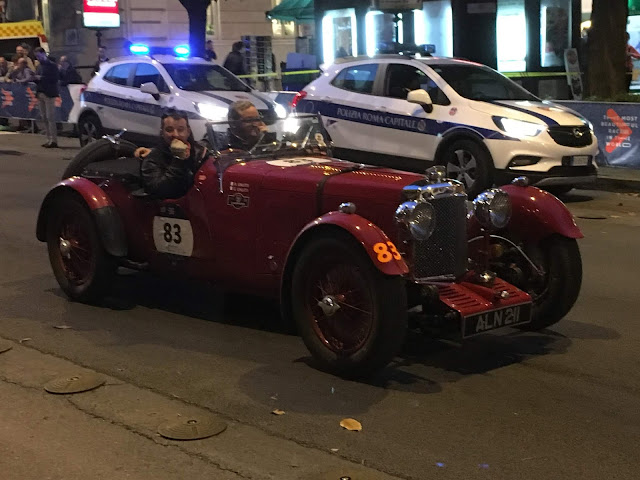We begin our second post on Mille Miglia 2018 with the car that many historians and engineers credit with beginning the modern era. The Lancia Lambda, introduced in 1922, was made in 9 slightly different series through 1931. Among its innovations, it introduced load-bearing unit body construction, independent front suspension (the famous sliding pillar type which lasted until the Aurelia of the 50s), and a single overhead cam V4 engine. It also had four-wheel brakes, another uncommon feature at this time, and was beyond doubt the first car to put all these cutting-edge features under one roof. On closed cars, though, that roof was not yet a part of the stressed unit structure. The Lambda wasn't a case of offering just a few hand-built specimens to get into the record books. Vincenzo Lancia's company built over 11,000 Lambdas during the 9-year production span. Engines were built in 2.1, 2.4 and 2.6 liter sizes, with power ranging from about 50 to 70 hp. The later example below is fetching in red, though the Lancia family's official racing entries were often painted blue...
The Fiat Balilla appeared in 1932 with a side-valve inline 4 of just under a liter. It produced 22 hp, and was designed for simplicity of manufacture and ease of maintenance. Soon enough, there were sports versions like the 508S spider below.
By 1934, the year the the pretty 508S Aerodynamica coupe shown below appeared, the sports Balilla offered an overhead valve version of the 995cc engine making 36 hp. The gearbox gained a speed that year with 4 speeds, the top two featuring synchromesh. This moment was likely the beginning of an era when Fiats formed the basis of countless racers built on a budget in privateer's garages, which after WWII became the etceterini movement. The Balilla roadster, based as it was on humble mass-produced parts, has often been compared to cars from Morris Garages...
Mentioning MG is our cue to introduce the sweet little boat-tailed C-Type Supercharged MG below. It's from 1932, and we can note that MG beat Jaguar to running at Le Mans with something called a C-Type competition car by almost 2 decades. The MG was a whole lot smaller than that Jag. With only 750cc, the example shown below used its supercharger and a single overhead cam inline 4 to win its class at the 24 hour race, and finished 6th overall in 1933.
We've slipped out of alphabetical order here, but at least it's in the midst of a trio of Brits, and anyway it's my blog and I can do what I want, so here's an Aston Martin from the early 1930s. This was in the era when Aston Martins were spindly 4-cylinder lightweights of 1.5 to 2 liters, only a bit more beefy than the Frazer Nash. In fact, Frazer Nash briefly owned Aston Martin in the 1930s. David Brown made the move to bigger engines after WWII with the W.O. Bentley-designed Lagonda twin-cam six, and a few decades later Ford ownership ushered in the era of V12-engined Aston supercars. There were several 1930s Astons in the MM this year. This one is not the boat-tailed Ulster model (the holy grail of interwar Astons), but any of the similar-looking Internationals or Le Mans roadsters would be welcome in an enthusiast's garage.
The fan-shaped grille is a clue that this white coupe is a Healey, in this case one of the 2.4 liter cars powered by a Riley inline 4 that appeared a few years before the Austin Healey 100-4 (with a flattened version of the fan grille) succeeded in making Healey famous in the USA, something even the Nash Healey had missed doing. This particular Healey is unusual in that it was bodied in Switzerland by Beutler coach works, which also built a couple of Bristols with similar flowing lines. The engine was interesting in that it was a twin-cam design, but not with overhead cams. Instead it featured gear-driven cams mounted high on the block and operating overhead valves in a cross-flow head through short pushrods*. This allowed hemispherical combustion chambers. This "underhead cam" engine was featured in Rileys from 1926 and also in ERA race cars, until BMC put an end to the party in 1957.

As Mercedes Benz was one of the sponsors of this year's events, it seems fitting to close with a shot of one of the 3 Mercedes SSK roadsters entered. This is probably over 10% of the world's supply of these 7.1 liter road rockets, as fewer than 40 were built in the first place, and one has to allow for attrition from race accidents, war, and the abandoned car syndrome (Briggs Cunningham used the body of a crashed SSK on his Buick-engined Bu-Merc). Ferdinand Porsche designed these before leaving Daimler Benz to head off in a different direction, actually several different directions involving mid-engined multicylinder racers, air-cooled people's cars and tanks. In the case of this SSK made from 1928 to 1932, he plugged a vast, single overhead cam six into a short chassis (116 in. wheelbase; the K is for kurz). The supercharged engine was lightly stressed, making only around 225 hp from over 7 liters.
*Footnote: The English Lea Francis also featured a similar "underhead cam" engine design, as did the post-WWII Talbot-Lago. The Lea Francis engine found its way into Connaught sports and racing cars, featured in our archives for 7/24/2016, entitled "Celtic Rainmaker."
Photo Credit:
All photos were provided by LT Jonathan D. Asbury USN.








No comments:
Post a Comment